|
Listening closely as I received permission to fish not one but two
(new to me) farm ponds, the surprise factor had me at a loss for
words. I'm just not used to hearing someone I've never met
before invite me to fish a couple of ponds he owns. My mind
was awkwardly trying to process this lightning bolt of good
fortune when the landowner let slip the magic word "crappie"
and I heard myself say,"Thank you! I'll try them both today!"
Fishing any body of water for the first time is fun, but sometimes
it can be a little nerve-racking? The excitement I felt at having this
opportunity was balanced by worries that I wouldn't catch anything;
maybe I wouldn't even get a hit. The end of October had come.
Northeast Kansas had just been visited by the fall season's first
serious cold spell. Overnight lows in the upper 20s and, of course,
wind. But this morning the sky was sunny and clear and the wind
wasn't too bad, a combination that gave the day a decent chance
at warming up.
Both of his ponds, the owner told me, are smaller and shallower
than the Watershed District retention pond he knew I'd been
fishing recently. Hearing this made me think his ponds would
probably have colder water in them after surrendering much of
their warmth to the clear night skies, as a thin aluminum oven
sheet cools fresh-baked cookies quicker than a cast iron Dutch
oven will cool a pot of beef stew. How active will the fish in
these two ponds be? Not very active, was my guess.
So I could draw a certain comfort from thinking that no matter
what I did as a fisherman I would likely not be seeing these ponds
at their best. Not today; the overnight lows had been too chilly for
too many nights in a row. Perhaps this fatalistic assumption was a
mind game I was playing on myself; whatever, it helped reduce the
pressure I felt to succeed. I mean, out of the blue somebody invites
me to fish their pond? Hey, I want to show them some results, like
I know what I'm doing?. Otherwise they might think I'm some sort
of fly fishing dummy…which I often am, but try constantly to
conceal it.
Driving onto his property, the first pond came into view and
I could tell right away that I was in trouble. The kind of trouble
I like. Everywhere along the shoreline were submerged limbs
with branch tips poking above water, and whole submerged
trees, too, all of these objects looking like they'd been dropped
at their exact spot by the owner himself specifically to provide
fish cover. And surrounding the pond were standing trees in
sufficient density that casting a fly rod anywhere from shore
would be tricky business indeed. In short, the place looked
really good.
Working this pond thoroughly and suffering as little pain as
possible meant using my canoe so that I could cast from
open water toward the snag-infested shore. The only
reason I didn't do this is because the owner had told me
his second pond was the biggest. I hadn't yet seen that
second pond and thought it prudent to spend the bulk of
my time there today, on the theory that the bigger pond
might also be deeper and thus a few degrees warmer?
So although this smaller, tree-shaded first pond looked
good I decided to sample it only briefly by means of
casting into it from shore, trusting to luck that I wouldn't
lose much tackle.
It was mid-morning, making it harder to evaluate the
probability of success; there were certainly no surface
disturbances to indicate fish activity. But then, even in
summertime the fish usually cease surface feeding around
this same time of day. Wonder what this pond looks and
sounds like on a mid-summer evening with June bugs falling
into the water? Looks pretty sleepy right now, that's for
sure.
Sleepy and asleep are two different states. My third cast
came down close to a poking branch top and on the drop
my nymph got clobbered by a bluegill. A few casts later
during a deep retrieve, a relative of that same branch took
Old Reliable into custody and he'll never see the light of
day again.
Tiptoeing to the pond's south side, the best place to operate
there was amidst a stand of trees whose lower limbs were
oriented such that I could safely backcast so long as I used
a sidearm delivery. But this took care of only half the problem;
the other half involved landing the four or five fish that I hooked
there.
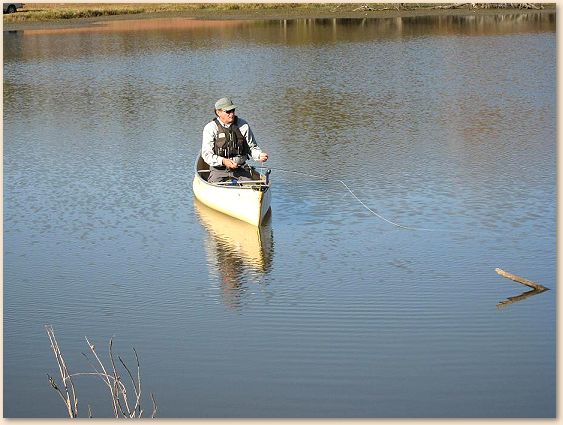
Into the cover
Hooked bluegills exhibit a genius IQ in how fast they half-hitch
your leader around solid objects they come near? A couple of
the fish zoomed into submerged shoreline branches and forced
me to play that old waiting game…will they, or will they not,
unwrap themselves if I cease all rod pressure?
Even with these difficulties it was becoming obvious that if I
committed serious time to this first pond I would likely have
some good bluegills to show for it. Maybe some crappies,
too– and this smaller pond is the one stocked with
crappies. Ah, but that second, bigger pond was waiting just
over the hill and it was calling to me.
Two fence gates later I reached the big pond. Near its upper
end I parked my pickup, unracked my canoe, rigged it with
anchors, loaded it with gear and launched.
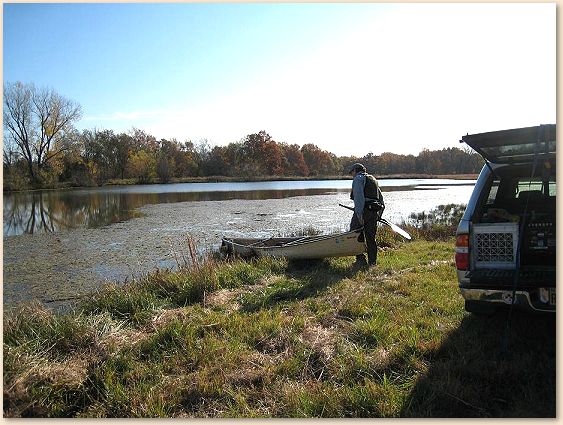
Launching at big pond
Of immediate interest was a long slot in the shoreline weedbed.
If I positioned my canoe correctly two or three times during my
slow approach to it, then again once I got there, I could work
perhaps two hundred linear feet of weedline cover. This place
had Bluegill written all over it. But I discovered on my first anchor
drops that the water here is quite shallow, most of it no more than
two feet deep. Initially this shallowness didn't concern me; my
very first cast caught a bluegill! But after that fish, no dice, even
though I switched patterns three times looking for a winner.
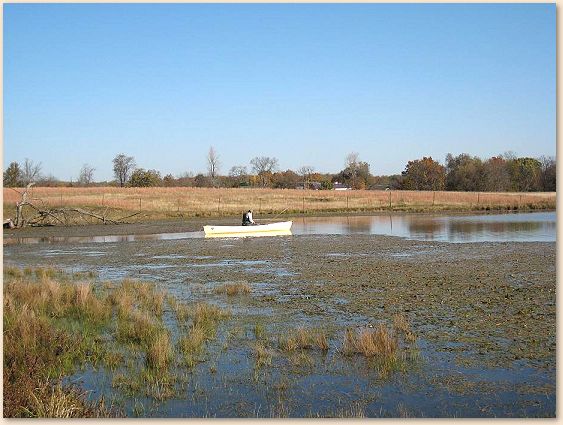
Surrounded by vegetation
The above photo illustrates a challenge faced by everyone who
fishes farm ponds: a dense weedbed that extends well beyond
the shoreline. Rare is the Kansas farm pond absent a similar
green border. In most cases this growth decays during the
winter months, leaving the pond's border clear and open as
the winter season moves into early spring.
For your typical aquatic pond plant; the spring transition
unleashes unbelievably rapid growth. This makes cabin
fever overrated as the presumed motive for why thousands
every year rush to go fishing at the first hint of spring weather.
Farm ponds are the #1 destination for Kansas anglers, and
statistically most farm ponds are shallow. People experienced
with ponds will fish them as soon as possible after ice-out, when
the shallows are warming up, when fish are in those shallows
becoming active…and before the pond's weeds go
berserk and bloom into a wrap-around barrier to shoreline
casting and retrieving.
I quit the shallows, moved to the dam and tried it there for
a while, using a couple of patterns without any noteworthy
success. My fish finder was in the boat today so I took the
opportunity to examine the depth along the dam.

Working the dam
The structure of this dam is such that the bottom falls away
very steeply, almost a 1/1 drop. I graphed a number of large
fish below me, but couldn't entice any of them to hit. And in
places along the dam and the adjacent north bank,
medium-sized trees and large shrubs have branches and
limbs that lean out over the water, creating excellent cover
for panfish and bass. Meal-producing cover, actually, just
like those pesky weed beds. This, too, looks like a good
pond. Time will tell whether I'm skilled enough to do anything
here; I sure didn't put any dents in it today.
On the way out, I drove across the small pond's dam. Halfway
over I glanced down into the water and saw, lined up like grocery
shoppers at the checkout counter, some one dozen bluegills and
small bass suspended just below the surface, their noses facing
into the wind-ruffled waves. The sun had reached its mid-day
high point, the water along the dam was warming up and these
fish knew it. With my polarized lenses I could see them moving
around looking, pausing, hunting. Any insect unfortunate enough
to fall into this pond and get blown to the dam would be a pork
chop thrown into a kennel of Rottweilers.
But I had to go; things to do back home.
I hope to hit these ponds again, next spring especially. You
know, if a person had permission to fish enough farm ponds
and developed a fair knowledge of their design and structure,
this would allow sequencing your springtime fishing trips to
match the prevailing weather conditions, so as to catch each
pond during its individual best window of opportunity. Kind of
like Rick Zieger does. I'll think about that this winter. ~ Joe
About Joe:
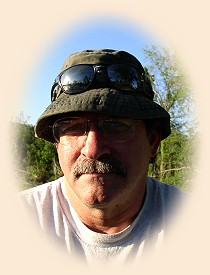 From Douglas County, Kansas, Joe is a former municipal and
federal police officer, now retired. In addition to fishing, he hunts
upland birds and waterfowl, and for the last 15 years
has pursued the sport of solo canoeing. On the nearby
Kansas River he has now logged nearly 5,000 river miles
while doing some 400 wilderness style canoe camping
trips. A musician/singer/songwriter as well, Joe recently
retired from the U.S. General Services Adminstration.
From Douglas County, Kansas, Joe is a former municipal and
federal police officer, now retired. In addition to fishing, he hunts
upland birds and waterfowl, and for the last 15 years
has pursued the sport of solo canoeing. On the nearby
Kansas River he has now logged nearly 5,000 river miles
while doing some 400 wilderness style canoe camping
trips. A musician/singer/songwriter as well, Joe recently
retired from the U.S. General Services Adminstration.
Joe at one time was a freelance photojournalist who wrote the
Sunday Outdoors column for his city newspaper. Outdoor
sports, writing and music have never earned him any money,
but remain priceless activities essential to surviving the
former 'day job.'
|
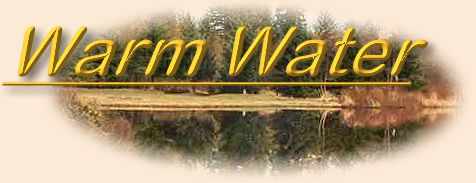




 From Douglas County, Kansas, Joe is a former municipal and
federal police officer, now retired. In addition to fishing, he hunts
upland birds and waterfowl, and for the last 15 years
has pursued the sport of solo canoeing. On the nearby
Kansas River he has now logged nearly 5,000 river miles
while doing some 400 wilderness style canoe camping
trips. A musician/singer/songwriter as well, Joe recently
retired from the U.S. General Services Adminstration.
From Douglas County, Kansas, Joe is a former municipal and
federal police officer, now retired. In addition to fishing, he hunts
upland birds and waterfowl, and for the last 15 years
has pursued the sport of solo canoeing. On the nearby
Kansas River he has now logged nearly 5,000 river miles
while doing some 400 wilderness style canoe camping
trips. A musician/singer/songwriter as well, Joe recently
retired from the U.S. General Services Adminstration.